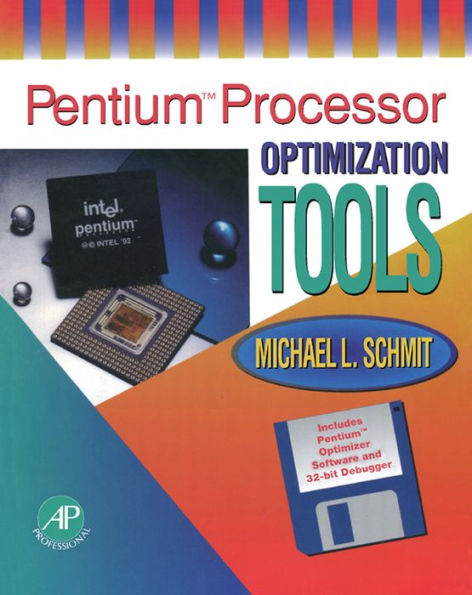5
1


eBook
$62.49
$72.95
Save 14%
Current price is $62.49, Original price is $72.95. You Save 14%.
Available on Compatible NOOK devices, the free NOOK App and in My Digital Library.
WANT A NOOK?
Explore Now
Related collections and offers
62.49
In Stock
Overview
Pentium Processor Optimization Tools covers advanced program optimization techniques for the Intel 80x86 family of chips, including the Pentium. The book starts by providing a review and history of the optimization tool. The text then discusses the 80x86 programming language; Pentium and its tools; and the superscalar Pentium programming. The operation of the floating-point unit; techniques for including assembly language routines in C or C++ programs; and the protected-mode programming are also considered. The book further tackles optimizations and code alignment; as well as the background and technical capabilities of the PowerPC vs. the Pentium and their future technical directions. Computer programmers and students taking related courses will find the book invaluable.

Product Details
| ISBN-13: | 9781483214252 |
|---|---|
| Publisher: | Elsevier Science |
| Publication date: | 06/28/2014 |
| Sold by: | Barnes & Noble |
| Format: | eBook |
| Pages: | 406 |
| File size: | 14 MB |
| Note: | This product may take a few minutes to download. |
Table of Contents
Introduction Who Is This Book For What Is on the Disk Why Learn Assembly Language for the Pentium How to Proceed Acknowledgments I Review and Historical Context 1 Number Systems Hex Signed Numbers Numeric Overflow Data Sizes Little Endian vs. Big Endian 2 What is Assembly Introduction Tools and Terminology What Are Compilers, Interpreters and Assemblers 3 The 8086 Family History and Architecture Compatibility Lessons Math Co-processors The 80286 32-bit 80386 RISCy 80486 The 80586 The Competition The P6 II 80x86 Family Background 4 8086 Architecture and Instruction Set 8088 Architecture The 8088 Instruction Set Program Control and Branching Flag Manipulations BCD Instructions String Instructions Interrupts Miscellaneous Instructions Flag Summary 5 Writing Beginning Programs What Do All Those Statements Mean Labels and Identifiers Procedures @Data Defining Data Items Using DOS System Functions The END Directive Memory Models 6 Assembly Tools Editing Assembling Linking Debugging DEBUG32 7 The Instruction Set Evolves: The 186 to the 386 The Lost Brother, the 80186 The 80286 The 80386 New 386 Addressing Modes New 386 Instructions Protected ModeIII Introduction to Pentium and Tools 8 The 80486 and Pentium Pentium Bigger Cache New Pentium Instructions Summary 9 Superscalar Programming Dual Integer Pipelines Branch Prediction Logic Optimized Cycle Times 10 Integer and Floating-Point Pipeline Operation The Memory Cache Pipelines Address Generation Interlock AGI) Paired Pipelines 486 Pipeline Delays Pentium Pipeline Delays Pentium Floating-Point Pipeline FPU Pipeline Delays Concurrent Integer and FPU Processing 11 Using the Pentium Optimizer Program How It Works Address Generation Interlocks ICE 12 Timing with a Software Timer Built-in Pentium Timer Software Timer Timer Software Function Reference Percent Speed Changes IV Superscalar Pentium Programming 13 Optimization Warm-Ups String Instruction Optimizations 14 String Search and Translate String Search String Translations Atomic Programming Coding Challenge Reality Check Case-Independent String Searching Case-Independent String Scan Case-Independent String Compare Conclusions 15 Checksums and Extended Precision Addition Step 1 Step 2 Step 3 Step 4 Step 5 Step 6 Coming Completely Undone Summary False Steps Extended Precision Addition V Advanced Topics 16 Floating-Point Math FPU Matrix Optimizations Which Array Declaration Is Best Optimizing with Assembly 17 Interfacing to C Inline Assembly Inline Assembly Example Linking Separate Modules Calling Conventions Full C-to-Assembly Templates Examples of Calling Assembly Routines from C Using the Extended PROC directive Fastcall Fastcall Registers Timing C Code 18 Protected-Mode Programming Introduction to Protected Mode DPMI, DOS Protected-Mode Interface Protected-Mode Segments Converting Code to Protected Mode Mixed 16-Bit and 32-Bit Protected-Mode Programming Full Segment Definitions Protected Mode Timing 32-bit Protected-Mode Code Template Large Data Segments Timing 32-Bit Code Cloaking Developers Toolkit 19 Final Notes and Optimizations Speed vs. Code Size LEA, the Multi-purpose Instruction Code and Data Alignment Local Stack Variables Measuring and Correcting the Data Misalignment Penalty Code Alignment Further Reading Where We've Been VI PowerPC vs. Pentium 20 20. Power PC VS. PENTIUM What Is RISC What Is CISC What Is RISC, Really Which Is Better, RISC or CISC Is the Pentium RISC or CISC Superscalar Processors Superscalar Techniques and Terminology What Is in the PowerPC Is the PowerPC Less Expensive Future Processor Designs Appendices A Instruction Set Reference Part I Part II B Optimization Cross-Reference by Instruction C Optimization Guidelines by CPU 8088 286 386 486 Pentium D Simple Instructions for Pentium Pairing E Instruction Pairing Rules for Pentium F Single-Byte Instructions Pairable One-byte Instructions Non-pairable One-byte Instructions Prefix Bytes G Quick Reference for Important Instruction Timings Important Combinations for the Pentium H Undocumented Pentium Registers I Debug32 Command Summary New Instructions J Improving Performance Other Pentium-class Machines K Glossary of Terms L Products Mentioned IndexFrom the B&N Reads Blog
Page 1 of
